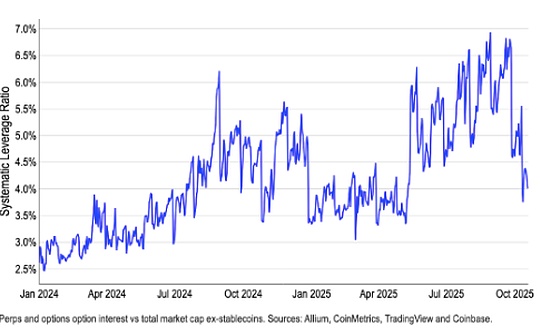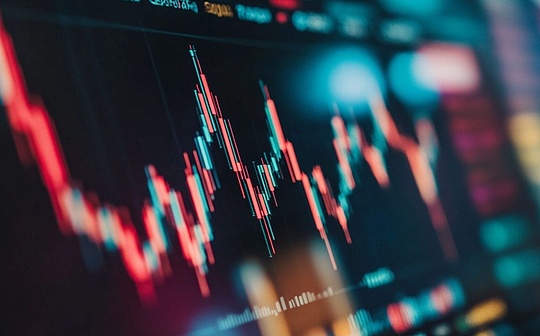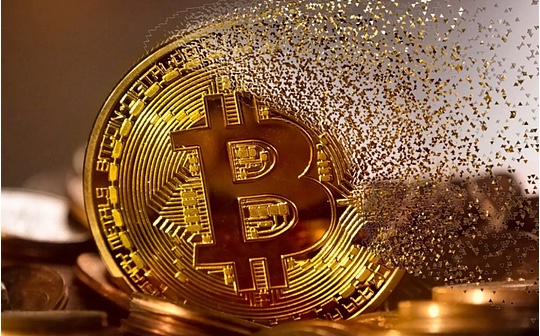
Author: Sleepy.txt

“The only way to win is to stay out of the game.”
Michael Burry wrote this on social media in October.It comes from the 1983 movie “War Games,” in which a supercomputer reaches this conclusion after repeatedly rehearsing nuclear war.
Days later, Burry disclosed its third-quarter holdings.The investor famous for his precise bets on the 2008 subprime mortgage crisis has bet nearly 80% of the assets in the funds he manages, about $1 billion, all in one direction – shorting Nvidia and Palantir.
In his opinion, the most powerful way not to participate in this irrational “long” carnival game is to short it.
Burry’s bet is not just on a few overvalued companies, but on the most powerful consensus of this era itself.Because in this consensus, AI is not only a technological revolution, but also the belief of capital.
But how is this consensus formed?How was it pushed to climax?As this faith machine continues to operate, what price are we paying for it?
gospel
Behind all financial manias is a story that is told over and over again and believed by countless people.
In this wave of AI, this story is written at a textbook level.It is completed by the combined efforts of three forces,Technology leaders are responsible for writing “myths”, Wall Street is responsible for providing “rationality”, and the media is responsible for completing “sermons”.
The first writers of the story were the evangelists of the Singularity.Technical leaders represented by OpenAI CEO Sam Altman and Google DeepMind co-founder Demis Hassabis have successfully portrayed general artificial intelligence, a distant concept that originally existed in science fiction and academic circles, as a “new god” that is close at hand, within reach, and can solve all major problems of mankind.
Altman repeated that sentence repeatedly during his global speech tour. AGI will be mankind’s “greatest technological leap so far” and the wealth it can bring will be “far beyond all of our imaginations.”Hassabis used more philosophical language, defining it as a tool to help humans understand the ultimate mystery of the universe.
Their language is full of religious enthusiasm for “the future” and “intelligence”, and they have successfully given this technological wave an almost sacred meaning that transcends business.
If technology leaders provide the script of the myth, then Wall Street and economists provide “rational” endorsement for this myth.
Against the background of slowing global economic growth and frequent geopolitical conflicts, AI was quickly chosen as the kind of “growth antidote” that can make capital believe in the future again.
Goldman Sachs released a report at the end of 2024, predicting that generative AI will bring a 7% increase to global GDP within ten years, approximately US$7 trillion.Almost at the same time, Morgan Stanley also gave a more ambitious definition, saying that AI is “the core of the fourth industrial revolution” and its productivity effect is comparable to steam engines and electricity.
What these numbers and metaphors really do is turn imagination into assets and beliefs into valuations.
Investors began to believe that giving Nvidia a P/E ratio of 60 times was not crazy. They were not buying a chip company, but the engine of the future global economy.
Since ChatGPT’s inception in November 2022, AI-related stocks have contributed 75% of S&P 500 returns, 80% of earnings growth, and 90% of capital expenditure growth.This technical narrative has almost become the only pillar supporting the entire US stock market.
Finally, the media and social networks become the ultimate amplifier of this myth.
From the stunning debut of Vincent’s video model Sora to every model update by giants such as Google and Meta, every node is amplified, cycled, and amplified again, and the algorithm pushes this belief into everyone’s timeline.
At the same time, the discussion of “AI replacing humans” is spreading like a shadow. From engineers to teachers, from designers to reporters, no one is sure whether they still belong to the next era.
When fear and awe spread simultaneously, a grand, almost unquestionable creation myth was written, paving the way for one of the largest gatherings of capital in human history.
machine
When the “gospel” spread to every corner of the world, a group of financial engineers who were best at structural design began to take action.
Their goal is to turn this abstract belief into a functioning machine, a capital system that can self-circulate and strengthen itself.It is not so much a bubble as it is a sophisticated financial engine whose complexity far exceeds the derivatives design of the 2008 generation.
The core of this machine is built by a handful of technology giants.They weave capital, computing power and income into a closed loop, in which funds flow, amplify and flow again, like a perpetually moving system driven by algorithms.
First, technology giants represented by Microsoft have invested huge sums of money in AI research institutions such as OpenAI.The company, which has made a habit of betting on infrastructure in the cloud computing era, has invested more than $13 billion in OpenAI.In a few years, OpenAI’s valuation has soared from several billion to nearly 100 billion U.S. dollars, becoming a new myth in the capital market.
The first thing that comes with huge financing is more expensive training.To build GPT-4, OpenAI used more than 25,000 Nvidia A100 GPUs, and the computing power requirements of the next generation model are still growing exponentially.These orders naturally flowed to the sole monopolist of the market, NVIDIA.
Nvidia’s data center revenue jumps from $4 billion in 2022 to $20 billion in 2025, with profit margins exceeding 70%.Its stock price soared, making it the most valuable company in the world.
It is precisely the major technology giants and institutional investors including Microsoft that hold a large number of NVIDIA stocks.The rise in NVIDIA’s stock price has made their balance sheet even more eye-catching.
The story is not over, training is just the beginning, and deployment is the main battlefield of expenditure.
OpenAI needs to host models in the cloud, and its largest partner is Microsoft.Billions of dollars in cloud service fees flow into Microsoft’s books every year, translating into the growth curve of Azure’s business.
A perfect closed loop is born.Microsoft invested in OpenAI, and OpenAI purchased Nvidia’s GPUs and Microsoft’s cloud services. The revenue growth of Nvidia and Microsoft pushed up the stock prices, and the rising stock prices made Microsoft’s investment look more successful.
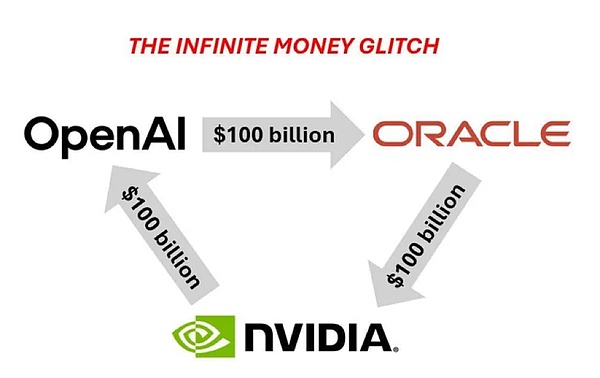
In this process, funds only flowed between a few giants, but huge “income” and “profits” were created out of thin air. The growth on the books supported each other, and the valuations increased each other.The machine starts feeding itself.It does not even require real demand from the real economy to achieve “perpetual motion.”
This core engine quickly expanded to all walks of life.
Fintech and the payments industry were among the first to be integrated.
Stripe is the most typical example.The payments company, valued at more than $100 billion, will process a total payment volume of $1.4 trillion in 2024, equivalent to 1.3% of global GDP.A year later, it announced a cooperation with OpenAI to launch the “instant checkout” function in ChatGPT, allowing the payment system to be truly embedded in the interaction scenario of the language model for the first time.
Stripe’s role in this wave is nuanced.It is not only a purchaser of AI infrastructure, constantly purchasing computing power in order to train more efficient fraud prevention systems and payment recommendation algorithms; it is also a direct beneficiary of AI commercialization, creating new transaction entrances by combining with language models, thus pushing up its own valuation.
PayPal follows closely behind.In October 2025, this established payment giant became the first wallet system to be fully integrated into ChatGPT.
But the ripples don’t stop with finance.Manufacturing is one of the first traditional industries to feel the shock. It used to rely on automated hardware and is now paying for algorithms.
In 2025, a German automaker announced that it would invest 5 billion euros within three years to promote AI transformation. Most of the funds will be used to purchase cloud services and GPUs to reshape the nervous system of production lines and supply chains.This is not an isolated case.Managers in industries such as automobiles, steel, and electronics are all trying to use similar methods to improve efficiency, as if computing power is the new fuel.
Retail, logistics, advertising, and almost every industry you can think of are experiencing similar changes.
They purchase AI computing power, sign cooperation agreements with model companies, and repeatedly emphasize their “AI strategy” in financial reports and investor meetings, as if those three words themselves can bring premiums.The capital market has indeed given rewards, with rising valuations, smoother financing, and a more complete narrative.
And the end point of all this almost points to the same companies.No matter which industry the funds flow out from, they will eventually return to core nodes such as NVIDIA, Microsoft, and OpenAI, flowing to GPUs, clouds, and models.As a result, their revenue continues to rise and their stock prices continue to rise, which in turn reinforces belief in the entire AI narrative.
cost
But this machine is not without roots.Its fuel comes from real economic and social resources, which are extracted, transformed, and burned into the roar of growth bit by bit.Those costs are often obscured by the noise of capital, but they do exist and are quietly reshaping the skeleton of the global economy.
The first price is the opportunity cost of capital.
In the world of venture capital, funds always pursue the direction with the highest return.The AI gold rush has created an unprecedented capital black hole.According to PitchBook data, about one-third of global venture capital investment will go to AI in 2024; by the first half of 2025, this proportion has climbed to a staggering two-thirds in the United States.
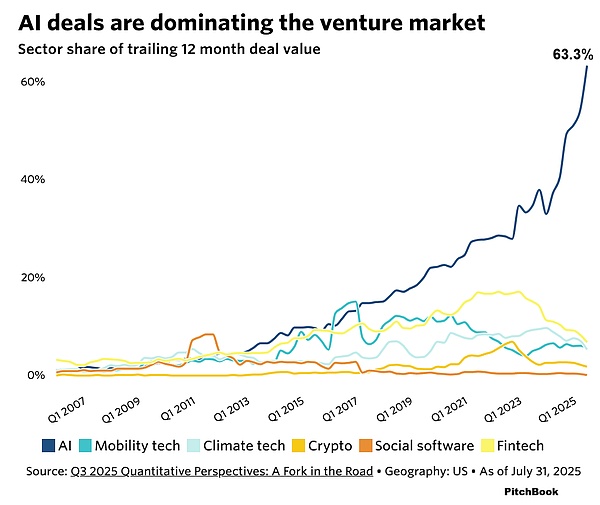
This means that capital that could have supported critical areas such as climate technology, biomedicine, and clean energy is being disproportionately sucked into the same story.
When all the smartest money is chasing the same story, the soil for innovation is being hollowed out.The focus of capital does not always mean increased efficiency; it often means the disappearance of diversity.
In 2024, global venture capital investment in clean energy will be only one-fifth that of AI.Climate change is still seen as humanity’s most urgent threat, but money is flowing toward computing power and models.Biotech’s situation is no different.Many entrepreneurs admitted in interviews that investors have little interest in their research because “AI stories are sexier and the return cycle is shorter.”
This kind of capital frenzy has approached a dangerous critical point.
Year-over-year growth in capital spending in the U.S. technology industry is now nearly equal to the peak of the dot-com bubble in 1999-2000.At that time, everyone was talking about the “new paradigm”, companies were expanding aggressively before they were profitable, and investors were rushing to bet on the vision of “changing the world.”Until the bubble burst, Nasdaq lost two-thirds of its market value, and Silicon Valley fell into a long winter.
Twenty-five years later, the same sentiments are sparked again, only with an AI as the protagonist.The capital expenditure curve is rising steeply again, and giants are investing tens of billions of dollars in building data centers and computing power clusters, as if the expenditure itself can bring a certain future.
The similarities in history are disturbing, and the ending may not be exactly the same, but this extremely concentrated capital momentum means that once the turning point arrives, the cost will be borne by the entire society.
The second price is the intellectual cost of talents.
This AI craze is creating an unprecedented intellectual siphon around the world.The top engineers, mathematicians, and physicists are being drawn in the same direction from the front lines of solving fundamental human problems.
In Silicon Valley, the scarcest resource today is not money, but top scientists in large model teams.The salaries offered to them by companies like Google, Meta, OpenAI, and others already dwarf all other science and engineering disciplines.
Industry data shows that the annual salary of an experienced AI research scientist can easily exceed one million US dollars; while in a university laboratory, a top physics professor often earns less than one-fifth of that.
Behind the pay gap is a shift in direction.The world’s brightest minds are withdrawing from long-term fields such as basic science, energy innovation, and biological research, and concentrating on the same highly commercialized track.Knowledge has never flowed so fast, but the river it flows through is getting narrower.
The third cost is the strategic cost of the industry.
Under the wave of AI, almost all companies in traditional industries have fallen into a passive anxiety.They are forced to join this expensive AI arms race, investing huge sums of money and building AI teams, even though most of them do not have a clear roadmap for return on investment.
According to data from Dell’Oro Group, global data center capital expenditures are expected to reach US$500 billion in 2025, most of which are related to AI; Amazon, Meta, Google, and Microsoft alone plan to invest more than US$200 billion.But this investment frenzy has long transcended the boundaries of the technology industry.
A large retail company announced at its financial report that it will invest tens of millions of dollars in the next three years to purchase AI computing power to optimize recommendation algorithms and inventory systems.
According to MIT research, the vast majority of investments in such projects do not bring enough benefits to cover the costs.For these companies, AI is not a tool, but a statement.This kind of investment is often not driven by active strategic needs, but by the fear of “falling behind the times.”
Changes in the situation
However, it is relatively one-sided to regard this AI wave as just a story of financial bubbles and resource misallocation.Because no matter whether the market tide rises or falls in the future, some profound and irreversible structural changes have already quietly occurred in this hustle and bustle.
“Intelligence” and the computing power that drives it are replacing traditional capital and labor and becoming the new basic production factor.
Its status is like electricity in the 19th century and the Internet in the 20th century. It is irreversible and indispensable.It is quietly penetrating into all industries, rewriting the cost structure and competitive order.
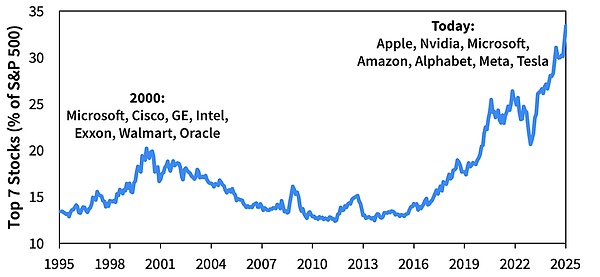
The total weight of the top 7 stocks in the S&P 500 Index at each point in time|Source: Sparkline
The competition for computing power has also become the oil race of this era.The ability to control advanced semiconductors and data centers is no longer just a matter of industrial competition, but is at the core of national security.
The United States’ Chip Act, the European Union’s technology export ban, and policy subsidies from East Asian countries have formed a new geoeconomic front. A global competition around computing power sovereignty is accelerating.
At the same time, AI is setting a new baseline for all industries.
Whether a company has a clear AI strategy has become the key to whether it can win the trust of the capital market and survive in future competition.Whether we are willing or not, we must learn to talk to the world in the language of AI. That is the new business grammar and the new rules of survival.
Michael Burry is not always right, and he has been wrong many times over the past dozen years.This bet may once again prove his foresight, or it may turn him into a tragic character who has been shuffled by the times.
But whatever the outcome, the world has been permanently changed by AI.Computing power has become the new oil, AI strategy has become a must-answer for corporate survival, and global capital, talent, and innovation resources are concentrating in this direction.
Even if the bubble bursts and the wave recedes, these changes will not disappear. They will continue to shape our world and become the irreversible backdrop of this era.

